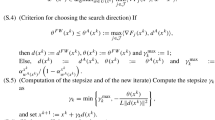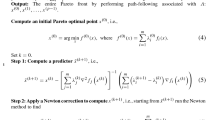Abstract
In this paper, we provide an easily satisfied relaxation condition for the primaldual interior path-following algorithm to solve linear programming problems. It is shown that the relaxed algorithm preserves the property of polynomial-time convergence. The computational results obtained by implementing two versions of the relaxed algorithm with slight modifications clearly demonstrate the potential in reducing computational efforts.
Similar content being viewed by others
References
E.R. Barnes, A variation of Karmarkar's algorithm for solving linear programming problems, Math. Progr. 36(1986)174–182.
S.C. Fang and S.C. Puthenpura,Linear Optimization and Extensions: Theory and Algorithms (Prentice-Hall, Englewood Cliffs, NJ, 1993).
P.H. Gill, W. Murray, M.A. Saunders, J.A. Tomlin and M.H. Wright, On projected Newton barrier methods for linear programming and an equivalence to Karmarkar's projective method, Math. Progr. 36(1986)183–209.
D. Goldfarb and S. Mehrotra, A relaxed version of Karmarkar's method, Math. Progr. 40 (1988)289–315.
D. Goldfarb and S. Mehrotra, Relaxed variants of Karmarkar's algorithm for linear programs with unknown optimal objective value, Math. Progr. 40(1988)183–195.
D. Goldfarb and M.J. Todd, Linear programming, Technical Report No. 777, Cornell University, School of Operations Research and Industrial Engineering, Ithaca, New York (1988).
C.C. Gonzaga, An algorithm for solving linear programming problems inO(n 3 L) operations, in:Progress in Mathematical Programming: Interior-Point and Related Methods, ed. N. Megiddo (Springer, New York, 1989) pp. 1–28.
T.-M. Hwang, C.-H. Lin, W.-W. Lin and S.-C. Fang, Relaxing interior path following primaldual algorithm for linear programming, OR Report No. 270, North Carolina State University, Raleigh, NC (1993).
N. Karmarkar, A new polynomial time algorithm for linear programming, Combinatorica 4 (1984)373–395.
M. Kojima, S. Mizumo and A. Yoshise, A primal-dual interior point method for linear programming, in:Progress in Mathematical Programming: Interior-Point and Related Methods, ed. N. Megiddo (Springer, New York, 1989) pp. 29–48.
I.J. Lustig, R.E. Marsten and D.F. Shanno, Computational, experience with a primal-dual interior point method for linear programming, Linear Algebra and its Applications 152 (1991)191–222.
N. Megiddo, Pathways to the optimal set in linear programming, in:Progress in Mathematical Programming: Interior-Point and Related Methods, ed. N. Megiddo (Springer, New York, 1989) pp. 131–158.
N. Megiddo,Progress in Mathematical Programming: Interior-Point and Related Methods (Springer-Verlag, New York, 1989).
R.C. Monteiro and I. Adler, Interior path following primal-dual algorithms, Part I: Linear programming, Math. Progr. 44(1989)27–41.
R.C. Monteiro and I. Adler, Interior path following primal-dual algorithms, Part II: Convex quadratic programming, Math. Progr. 44 (1989)43–66.
R.J. Vanderbei, M.S. Meketon and B.A. Freeman, A modification of Karmarkar's linear programming algorithm, Algorithmica 1(1986)395–407.
Author information
Authors and Affiliations
Additional information
Partially supported by the North Carolina Supercomputing Center, the 1993 Cray Research Award, and a National Science Council Research Grant of the Republic of China.
Rights and permissions
About this article
Cite this article
Hwang, TM., Lin, CH., Lin, WW. et al. A relaxed primal-dual path-following algorithm for linear programming. Ann Oper Res 62, 173–196 (1996). https://doi.org/10.1007/BF02206816
Issue Date:
DOI: https://doi.org/10.1007/BF02206816




